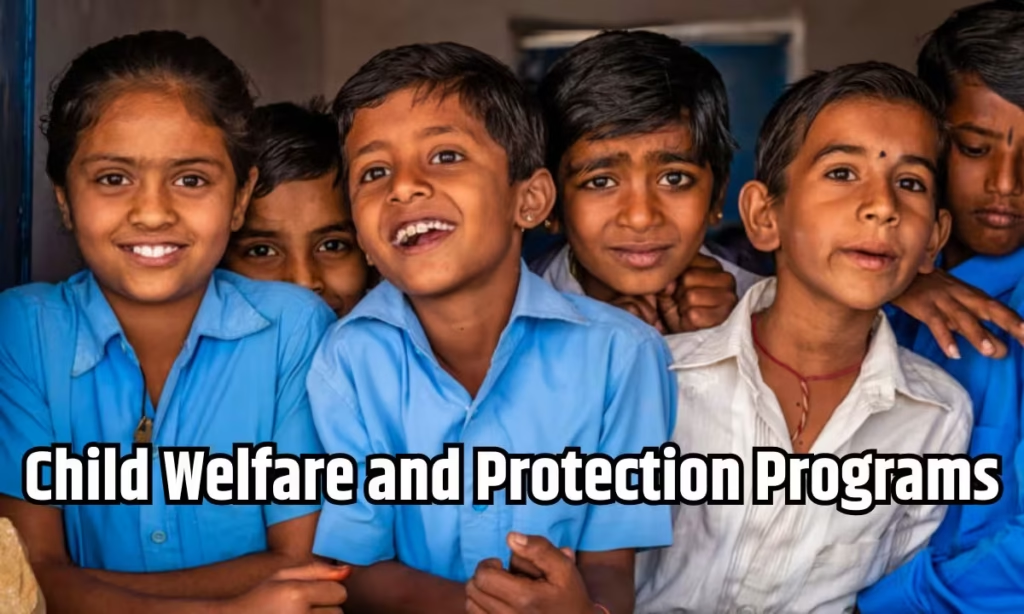Child Welfare and Protection Programs: In a world where nearly 138 million children are still trapped in child labor, often in hazardous conditions that rob them of their childhood, the need for robust child welfare and protection programs has never been more urgent. These young lives, especially in marginalized communities, face barriers like poverty, conflict, and discrimination that push them into exploitative work instead of playgrounds and classrooms.
But there’s hope: innovative programs worldwide are stepping up to prevent child labor, promote fundamental rights, and provide safe havens, nutritious meals, and quality education. This blog post dives deep into these efforts, exploring how they transform lives and build brighter futures. Whether you’re a parent, educator, or advocate, understanding these initiatives can inspire action and drive change.
Child Welfare and Protection Programs
Child labor isn’t just kids helping out at home—it’s any work that harms their health, education, or well-being. From toiling in factories and mines to scavenging in streets, it affects millions, with over 54 million in dangerous roles that jeopardize their safety. In developing regions, poverty drives families to rely on children’s earnings, while conflicts displace kids into exploitative situations. The consequences are devastating: physical injuries, stunted growth, and missed schooling perpetuate cycles of poverty.

Preventing this starts with awareness and intervention. Programs focus on root causes like economic hardship and lack of alternatives. For instance, community-based initiatives offer stipends to families, replacing lost income so kids can attend school. Others provide vocational training for parents, ensuring sustainable livelihoods. By addressing these triggers, we can reduce instances where children are forced into labor, allowing them to thrive instead.
Championing Child Rights: Building a Foundation for Equality
Every child deserves rights that protect them from harm and ensure their voices are heard. These include the right to education, health, play, and protection from exploitation. Yet, in marginalized communities—often Indigenous, Black, or low-income groups—these rights are frequently violated due to systemic biases and resource shortages.
Promotion efforts emphasize empowerment and inclusion. Campaigns rally communities to recognize and uphold these rights, involving kids in decision-making processes. For example, youth-led advocacy groups amplify marginalized voices, pushing for policies that address disparities. Education on rights equips children to speak up against abuses, fostering resilience. By integrating these into school curriculums and community workshops, programs create environments where equality isn’t just a goal but a reality.
The Role of Safe Spaces in Child Protection
Imagine a place where a child fleeing danger can find solace, play freely, and receive support—that’s the essence of safe spaces. These dedicated areas, often in schools, community centers, or temporary shelters during crises, shield vulnerable kids from violence, abuse, and exploitation.
In emergencies like conflicts or natural disasters, child-friendly spaces become lifelines, offering structured activities that restore normalcy. They include play areas, counseling, and peer support to help process trauma. For everyday protection, programs establish inclusive environments with peer-led activities that reduce isolation and build positive relationships. By partnering with local organizations, these spaces connect kids to essential services, ensuring they’re not just safe but also empowered to grow.
Nutrition Programs That Nourish Young Lives
Nutrition is the cornerstone of healthy development, yet many children in marginalized areas suffer from malnutrition, which impairs learning and increases vulnerability to diseases. Programs tackle this by providing balanced meals, supplements, and education on healthy eating.
School-based feeding initiatives deliver daily meals, keeping kids in class while addressing hunger. Community gardens and cooking classes teach families sustainable practices, empowering them to grow nutrient-rich foods. In low-income settings, micronutrient programs combat deficiencies like iron or vitamin A shortages, boosting immunity and cognitive skills. These efforts not only improve physical health but also enhance focus and academic performance, breaking the hunger-poverty cycle.
Education Initiatives for Children
Education is a powerful tool against child labor and inequality, yet millions of kids lack access due to barriers like distance, cost, or discrimination. Initiatives bridge this gap by creating inclusive systems that reach the hardest-to-reach.
Alternative learning pathways offer flexible schooling for out-of-school children, including mobile classrooms in remote areas. Scholarships and free supplies remove financial hurdles, while culturally sensitive curriculums affirm diverse backgrounds. Programs also focus on foundational skills like reading and math, ensuring no child is left behind. By strengthening teacher training and community involvement, these efforts unlock potential, equipping kids with life skills for better futures.
Challenges in Child Welfare and How to Address Them
Despite progress, obstacles remain. Funding gaps limit program reach, while cultural norms in some communities resist change. Conflicts exacerbate vulnerabilities, displacing families and disrupting services.
Solutions lie in multi-sector partnerships. Governments must enforce laws against child labor, while international aid bolsters local efforts. Community engagement ensures programs are culturally relevant, increasing buy-in. Monitoring and data collection help refine strategies, adapting to emerging needs like climate-induced displacements.
Wrapping Up: A Call to Action for a Child-Friendly World
Child welfare and protection programs are more than initiatives—they’re lifelines that prevent exploitation, uphold rights, and nurture potential in marginalized communities. By tackling child labor, creating safe spaces, ensuring nutrition, and expanding education, we’re investing in a generation that can break free from adversity. But progress requires collective effort: support local organizations, push for policy changes, and spread the word. Together, we can create a world where every child thrives, not just survives. Let’s commit to safeguarding tomorrow, one young life at a time.
FAQs: Answering Your Questions on Child Welfare and Protection
What exactly is child labor?
Child labor refers to work that deprives children of their childhood, interferes with schooling, or is harmful to their physical and mental development. It includes hazardous jobs like mining or factory work, often driven by poverty.
How can individuals help prevent child labor?
Support ethical brands that avoid child labor, donate to reputable organizations, volunteer in local programs, or advocate for stronger policies. Educating others about the issue also raises awareness.
What are the key child rights?
Under international standards, children have rights to education, health, protection from harm, play, and non-discrimination. These ensure they grow up safe and empowered.
Why focus on marginalized communities?
These groups face higher risks due to poverty, discrimination, and limited resources. Targeted programs address inequities, promoting broader societal progress.
How do safe spaces benefit children?
They provide emotional support, activities for healing, and access to services, helping kids cope with trauma and build resilience in unsafe environments.
What role does nutrition play in child development?
Good nutrition supports physical growth, brain function, and immunity. Without it, kids face stunted development, poor learning, and health issues.
Are education programs effective for marginalized kids?
Yes, when inclusive and flexible, they boost enrollment, skills, and opportunities, breaking poverty cycles and reducing child labor reliance.
How can we measure program success?
Through metrics like reduced child labor rates, improved school attendance, health indicators, and community feedback, ensuring long-term impact.
